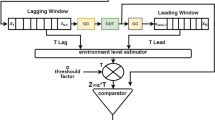Abstract
In this paper, we quantify the temporal opportunities for secondary access to radar spectrum. Secondary users are assumed to be WLANs which opportunistically share the radar frequency band under the constraint that the aggregate interference does not harm radar operation. Each WLAN device employs dynamic frequency selection (DFS) as a mechanism to protect the radar from the interference. We also consider an advanced interference protection mechanism, which is termed temporal DFS. It exploits the temporal variation of interference power due to the periodic rotation of radar antenna. It is observed that the probability of accessing the radar spectrum is significantly higher when the temporal DFS is used compared to the conventional DFS. As a consequence, more WLANs can utilize the radar spectrum when the temporal DFS mechanism is considered. This shows that having better knowledge of the primary user activity can bring about the increased opportunity of secondary spectrum access to radar band, and thus improve the spectrum utilization.






Similar content being viewed by others
References
Federal Communications Commission. (2002). Report of the spectrum efficiency working group. http://www.fcc.gov/sptf/reports.html.
Shared Spectrum Company. Spectrum reports. http://www.sharedspectrum.com/papers/spectrum-reports/.
Tercero, M., Sung, K. W., & Zander, J. (2011). Impact of aggregate interference on meteorological radar from secondary users. In Proceedings of IEEE WCNC, Cancun, Mexico.
ETSI EN 301 893 V1.5.1. (2008). Broadband Radio Access Networks (BRAN); 5 GHz high performance RLAN; harmonized EN covering the essential requirements of article 3.2 of the R &TTE directive. http://www.etsi.org/deliver/etsi_en/301800_301899/301893/01.05.01_60/en_301893v010501p.pdf.
Sung, K. W., Kim, S.-L., & Zander, J. (2010). Temporal spectrum sharing based on primary user activity prediction. IEEE Transactions on Wireless Communications, 9(12), 3848–3855.
Horváth, Z., & Varga, D. (2009). Channel allocation technique for eliminating interference caused by RLANs on meteorological radars in 5 GHz band. Infocommunications Journal, 64(3), 24–34.
Sung, K. W., Tercero, M., & Zander, J. (2011). Aggregate interference in secondary access with interference protection. IEEE Communications Letters, 15(6), 629–631.
Sung, K. W., Obregon, E., & Zander, J. (2011). On the requirements of secondary access to 960–1215 MHz aeronautical spectrum. In Proceedings of IEEE DySPAN, Aachen, Germany.
Rec. ITU-R M.1638. (2003). Characteristics and protection criteria for sharing studies for radiolocation, aeronautical radionavigation and meteorological radars operating in the frequency bands between 5250 and 5850 MHz. http://www.itu.int/dms_pubrec/itu-r/rec/m/R-REC-M.1638-0-200306-I!!PDF-A.pdf.
Tercero, M., Sung, K. W., & Zander, J. (2011). Aggregate interference from secondary users with heterogeneous density. In Proceedings of IEEE PIMRC, Toronto, Canada.
IST-4-027756 WINNER II. D1.1.2 v1.2 WINNER II channel models https://www.ist-winner.org/WINNER2-Deliverables/.
Acknowledgments
The research leading to these results has received partial funding from the European Union’s Seventh Framework Programme FP7/2007-2013 under grant agreement 248303 (QUASAR). The authors also would like to acknowledge the VINNOVA project MODyS for providing partial funding.
Author information
Authors and Affiliations
Corresponding author
Rights and permissions
About this article
Cite this article
Tercero, M., Sung, K.W. & Zander, J. Exploiting Temporal Secondary Access Opportunities in Radar Spectrum. Wireless Pers Commun 72, 1663–1674 (2013). https://doi.org/10.1007/s11277-013-1127-7
Published:
Issue Date:
DOI: https://doi.org/10.1007/s11277-013-1127-7




